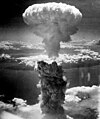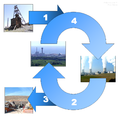The Nuclear Technology Portal

- Nuclear technology is technology that involves the nuclear reactions of atomic nuclei. Among the notable nuclear technologies are nuclear reactors, nuclear medicine and nuclear weapons. It is also used, among other things, in smoke detectors and gun sights. (Full article...)
- Nuclear power is the use of nuclear reactions to produce electricity. Nuclear power can be obtained from nuclear fission, nuclear decay and nuclear fusion reactions. Presently, the vast majority of electricity from nuclear power is produced by nuclear fission of uranium and plutonium in nuclear power plants. Nuclear decay processes are used in niche applications such as radioisotope thermoelectric generators in some space probes such as Voyager 2. Reactors producing controlled fusion power have been operated since 1958, but have yet to generate net power and are not expected to be commercially available in the near future. (Full article...)
- A nuclear weapon is an explosive device that derives its destructive force from nuclear reactions, either fission (fission bomb) or a combination of fission and fusion reactions (thermonuclear bomb), producing a nuclear explosion. Both bomb types release large quantities of energy from relatively small amounts of matter. (Full article...)
Polaris itself was an operational system of four Resolution-class ballistic missile submarines, each armed with 16 Polaris A-3 ballistic missiles. Each missile was able to deliver three ET.317 thermonuclear warheads. This configuration was later upgraded to carry two warheads hardened against the effects of radiation and nuclear electromagnetic pulse, along with a range of decoys.
The British Polaris programme was announced in December 1962 following the Nassau Agreement between the US and the UK. The Polaris Sales Agreement provided the formal framework for cooperation. Construction of the submarines began in 1964, and the first patrol took place in June 1968. All four boats were operational in December 1969. They were operated by the Royal Navy, and based at Clyde Naval Base on Scotland's west coast, a few miles from Glasgow. At least one submarine was always on patrol to provide a continuous at-sea deterrent.
In the 1970s it was considered that the re-entry vehicles were vulnerable to the Soviet anti-ballistic missile screen concentrated around Moscow. To ensure that a credible and independent nuclear deterrent was maintained, the UK developed an improved front end named Chevaline. There was controversy when this project became public knowledge in 1980, as it had been kept secret by four successive governments while incurring huge expenditure. Polaris patrols continued until May 1996, by which time the phased handover to the replacement Trident system had been completed. (Full article...)
- ... that the area of Cultybraggan Camp has been a royal hunting ground, a prison for fervent Nazis and the site of an underground bunker intended for use in a nuclear war?
- ... that the British National Hospital Service Reserve trained volunteers to carry out first aid in the aftermath of a nuclear or chemical attack?
- ... that a nuclear reactor was nearly built at the New York Hall of Science, but the money for the institution instead went to Yankee Stadium?
- ... that coral cores from Flinders Reef capture environmental changes caused by the use of nuclear weapons?
- ... that after journalist Adele Ferguson's criticism of the U.S. Navy's sex discrimination attracted nationwide attention, she was offered a personal tour of a nuclear submarine?
- ... that according to witnesses, the plutonium charge in the bomb used in the nuclear weapons test Gerboise Verte was transported in an economy car?
| Parts of this portal (those related to section) need to be updated. Please help update this portal to reflect recent events or newly available information. Relevant discussion may be found on the talk page. (September 2021) |
Born in Boyarka in the old Russian Empire, into "an old Ukrainian Cossack family which was part of the intellectual elite in pre-revolutionary Russia", Kistiakowsky fled his homeland during the Russian Civil War. He made his way to Germany, where he earned his PhD in physical chemistry under the supervision of Max Bodenstein at the University of Berlin. He emigrated to the United States in 1926, where he joined the faculty of Harvard University in 1930, and became a citizen in 1933.
During World War II, Kistiakowsky was the head of the National Defense Research Committee (NDRC) section responsible for the development of explosives, and the technical director of the Explosives Research Laboratory (ERL), where he oversaw the development of new explosives, including RDX and HMX. He was involved in research into the hydrodynamic theory of explosions, and the development of shaped charges. In October 1943, he was brought into the Manhattan Project as a consultant. He was soon placed in charge of X Division, which was responsible for the development of the explosive lenses necessary for an implosion-type nuclear weapon. In July 1945, he watched the first atomic explosion in the Trinity test. A few weeks later, another implosion-type weapon (Fat Man) was dropped on Nagasaki.
From 1962 to 1965, Kistiakowsky chaired the National Academy of Sciences's Committee on Science, Engineering, and Public Policy (COSEPUP), and was its vice president from 1965 to 1973. He severed his connections with the government in protest against the war in Vietnam, and became active in an antiwar organization, the Council for a Livable World, becoming its chairman in 1977. (Full article...)
- 15 October 2024 –
- Google signs an agreement with Kairos Power to use small nuclear reactors to generate the energy to power its artificial intelligence (AI) data centers. (BBC News)
- 11 October 2024 – 2024 Nobel Peace Prize
- This year's Nobel Peace Prize is awarded to Japanese atomic bomb survivors group Nihon Hidankyo for "its efforts to achieve a world free of nuclear weapons and for demonstrating through witness testimony that nuclear weapons must never be used again". (The Washington Post) (Nobel Prize)
The following Wikimedia Foundation sister projects provide more on this subject:
-
Commons
Free media repository -
Wikibooks
Free textbooks and manuals -
Wikidata
Free knowledge base -
Wikinews
Free-content news -
Wikiquote
Collection of quotations -
Wikisource
Free-content library -
Wikiversity
Free learning tools -
Wiktionary
Dictionary and thesaurus






































































































